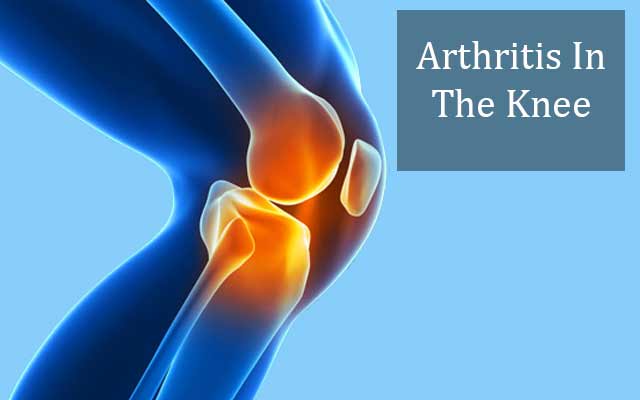
DAVE WATTS, MD
Orthopedic Surgeon
Arthritis In The Knee – Signs and Treatment
Your knee can get affected by various kinds of knee arthritis.
Let us have a look at the different types of knee arthritis.
Osteoarthritis
The common type of arthritis in the knee is osteoarthritis. Osteoarthritis is a condition which gradually wears down the knee joint cartilage. Patients in the middle age usually get affected because of this type of arthritis.
Post-Traumatic Arthritis
The post-traumatic arthritis develops after an injury. It may take years after an injury like knee fracture, ligament injury, or torn meniscus to show up.
Rheumatoid Arthritis
Rheumatoid arthritis causes inflammation in the knee. There is no age for developing this kind of arthritis in the knee.
Common Signs of Arthritis in the Knee
Let us have a look at some of the common signs of arthritis in the knee.
Knee Deformity
The arthritis in the knee can cause changes in the shape of the knee. There is a sunken appearance of the muscles around the knee. The arthritis weakens the surrounding muscles. This knee deformity will result in the knees pointing towards or away from each other. The appearance may not be noticeable or very apparent. The level of deformity of the knees depends on the extent of damage done by the arthritis.
No Space Between the Joint
An X-ray is the best way to determine the space between the knee joint. A reduction in joint space can result in reduced range of motions. The arthritis wears away the joint’s edges and reflects human body’s own effort to repair itself. These symptoms usually point to osteoarthritis.
Lack of Mobility
Lack of mobility is another important system of arthritis in the knee. The arthritis makes it difficult for knee joints to glide. The lack of mobility makes even simple movements difficult. The decrease in range of motions becomes more evident when you participate in sports related activities. The arthritis affects functioning of the knee joint and creates hurdles in performing everyday tasks.
Popping or Cracking Sounds
Another symptom is the feeling of a grinding sensation when you move your knee. The patient may hear popping or cracking sounds from their knees. The loss of smooth cartilage points to the effects of arthritis. The grinding sounds come out because of the roughing of the surfaces. These sounds may come out because of rubbing as well.
Locking of the Knee
Arthritis in the knee may weaken the muscles surrounding the joint. It may lead to weakening and destabilizing the joint structure. Weakness in the knee can result in giving away or locking. The joint may become sticky and may not bend or straighten. These symptoms can vary from one patient to another.
Tenderness or Swelling
The arthritis can also cause inflammation in the knee. Sometimes, there is inflammation because of extra fluids or bone spurs. Swelling can occur after a long period without physical activity. The condition may lead to feeling of warmth or redness on the skin. This may also cause chronic knee inflammation which can improve with the use of over the counter medicines.
Let us have a look at some of the ways to comfort the arthritis affected knee.
Take Rest
The feeling of little discomfort in the knee joint is normal. You may feel a bit of stiffness when you start a routine exercise. If you feel uneasiness and pain the knee, you should stop the physical activity. You need to take rest. It usually takes 2 to 4 days for the routine knee pain to subside. However, if you do not find any relief after a few days rest, you must get in touch with an orthopedic doctor.
Reduce Physical Activity
Exercise forms an important part of a healthy life. However, patients with osteoarthritis must avoid activities which would aggravate their pain. Sports activities involving a lot of physical activity should be avoided. However, it does not mean the patient should leave all physical activities. A patient needs to do some kind of physical activity without straining their knee joint. Inactivity is also not good for patients with arthritis in the knee.
Exercise and Physical Therapy
Exercise and physical therapy can help reduce the pain. The doctor will advise you with the right kind of exercise to take care of your health. Similarly, you must be careful in choosing the right exercise for yourself. Always consult with your orthopedic surgeon before choosing a workout routine. Some exercises may not be suitable for the arthritis in the knee.
Reduce Weight
Arthritis is a painful condition. A patient weighing more than their BMI adds stress to the knee. One way of helping patients with arthritis means management of their body weight. An overweight person puts a lot of extra pressure on their knee joints. Consult your orthopedic doctor in Sioux Falls to know about how weight reduction can help overcome knee arthritis pain.
Use of Injections for Knee Osteoarthritis
Your orthopedic surgery doctor may suggest the use of hyaluronan injections. These injections are also known as viscosupplementation. Some of the choices include injections containing sodium hyaluronate, euflexxa, orthovisc, and supartz. You must always take the advice of your doctor. Your orthopedic surgery doctor is the best person to decide on the type of medication to help with knee arthritis.
These injections have fluid which acts as a shock absorber. The fluid helps reduce the friction between the bones of the knee joint. The liquid helps the bone joint easily glide and reduces chances of osteoarthritis.
